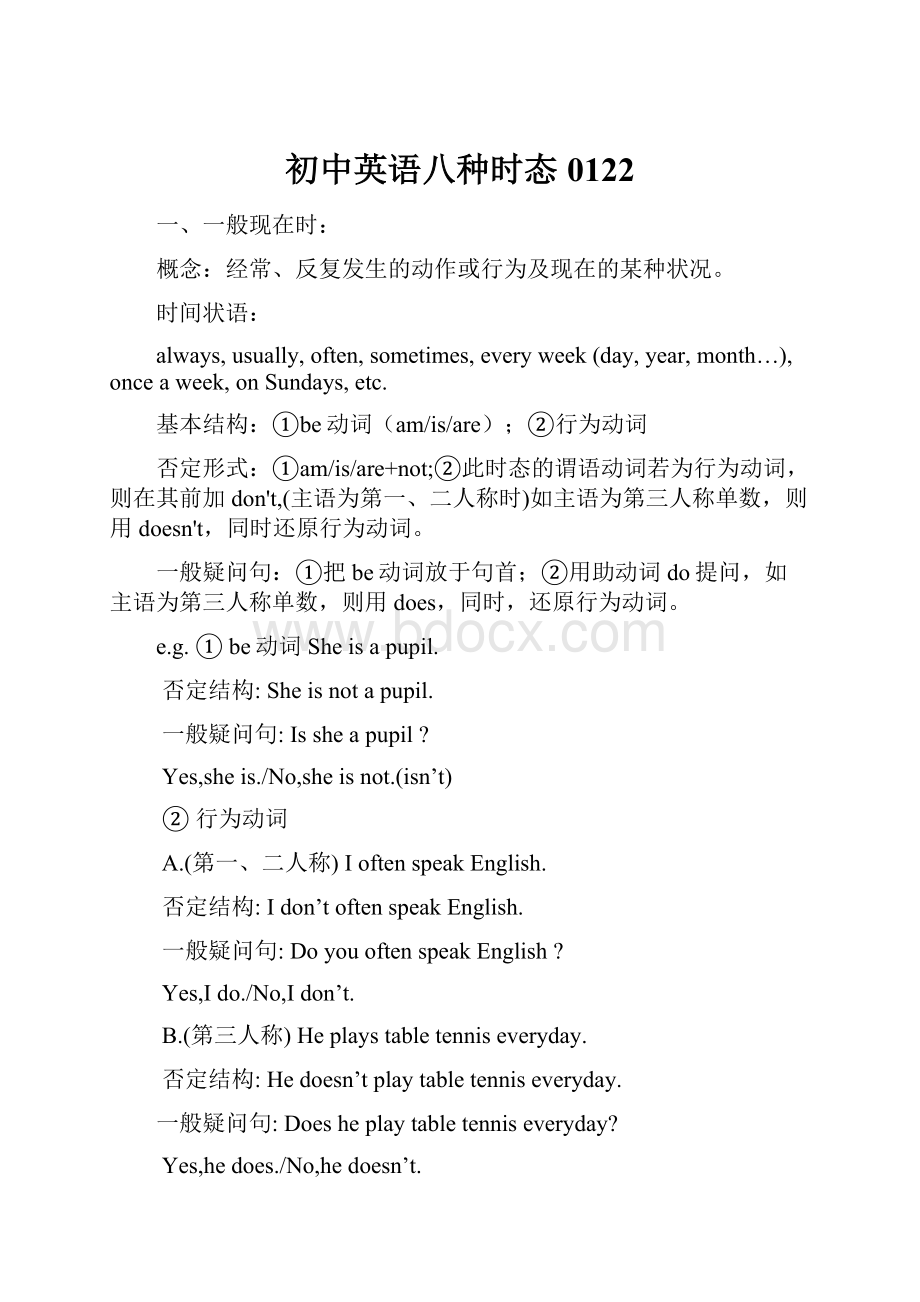初中英语八种时态0122.docx
《初中英语八种时态0122.docx》由会员分享,可在线阅读,更多相关《初中英语八种时态0122.docx(6页珍藏版)》请在冰豆网上搜索。

初中英语八种时态0122
一、一般现在时:
概念:
经常、反复发生的动作或行为及现在的某种状况。
时间状语:
always,usually,often,sometimes,everyweek(day,year,month…),onceaweek,onSundays,etc.
基本结构:
①be动词(am/is/are);②行为动词
否定形式:
①am/is/are+not;②此时态的谓语动词若为行为动词,则在其前加don't,(主语为第一、二人称时)如主语为第三人称单数,则用doesn't,同时还原行为动词。
一般疑问句:
①把be动词放于句首;②用助动词do提问,如主语为第三人称单数,则用does,同时,还原行为动词。
e.g.①be动词Sheisapupil.
否定结构:
Sheisnotapupil.
一般疑问句:
Issheapupil?
Yes,sheis./No,sheisnot.(isn’t)
②行为动词
A.(第一、二人称)IoftenspeakEnglish.
否定结构:
Idon’toftenspeakEnglish.
一般疑问句:
DoyouoftenspeakEnglish?
Yes,Ido./No,Idon’t.
B.(第三人称)Heplaystabletenniseveryday.
否定结构:
Hedoesn’tplaytabletenniseveryday.
一般疑问句:
Doesheplaytabletenniseveryday?
Yes,hedoes./No,hedoesn’t.
二、一般过去时:
概念:
过去某个时间里发生的动作或状态;过去习惯性、经常性的动作、行为。
时间状语:
ago,yesterday,thedaybeforeyesterday,lastweek(year,night,month…),in1989,justnow,attheageof5,oneday,longlongago,onceuponatime,etc.
基本结构:
①be动词;②行为动词的过去式
否定形式:
①was/were+not;②在行为动词前加didn't,同时还原行为动词。
一般疑问句:
①was或were放于句首;②用助动词do的过去式did提问,同时还原行为动词。
e.g.①be动词
Shewasapupil.
否:
Shewasnotapupil.
疑:
Wassheapupil?
回答:
Yes,shewas./No,shewasn’t
②行为动词的过去式
HetaughtEnglishlastyear.
否:
Hedidn’tteachEnglishlastyear.
疑:
DidheteachEnglishlastyear?
回答:
Yes,hedid./No,hedidn’t.
三、现在进行时:
概念:
表示现阶段或说话时正在进行的动作及行为。
时间状语:
now,atthistime,thesedays,etc.
基本结构:
am/is/are+doing
否定形式:
am/is/are+not+doing.
一般疑问句:
把be动词放于句首。
e.g.IamreadinganEnglishbook(now).
Sheissendinganemailtohisfamily.
Theyareplayingfootballintheplayground.
否:
IamnotreadinganEnglishbook(now).
疑:
AreyoureadinganEnglishbook(now)?
回答:
Yes,Iam./No,Iamnot.
四、过去进行时:
概念:
表示过去某段时间或某一时刻正在发生或进行的行为或动作。
时间状语:
atthistimeyesterday,atthattime或以when引导的谓语动词是一般过去时的时间状语等。
基本结构:
was/were+doing
否定形式:
was/were+not+doing.
一般疑问句:
把was或were放于句首。
e.g.ShewasreadinganEnglishbookatthistimeyesterday.
否:
ShewasnotreadinganEnglishbookatthistimeyesterday.
疑:
WasshereadinganEnglishbookatthistimeyesterday?
回答:
Yes,shewas./No,shewasn’t.
五、现在完成时:
概念:
过去发生或已经完成的动作对现在造成的影响或结果,或从过去已经开始,持续到现在的动作或状态。
时间状语:
recently,lately,since…for…,inthepastfewyears,etc.
基本结构:
have/has+done
否定形式:
have/has+not+done.
一般疑问句:
have或has。
E.g.Shehasseenthenewfilm.
否:
Shehasn'tseenthenewfilmyet.
疑:
Hassheseenthenewfilm?
(Yes,shehas./No,shehasn’t)
ShehasbeentoShanghai.
否:
Shehasn’tbeentoShanghai.
(ShehasgonetoShanghai.)
疑:
HasshebeentoShanghai?
(Yes,shehas./No,shehasn’t)
六、过去完成时:
概念:
以过去某个时间为标准,在此以前发生的动作或行为,或在过去某动作之前完成的行为,即“过去的过去”。
时间状语:
before,bytheendoflastyear(term,month…),etc.
基本结构:
had+done.
否定形式:
had+not+done.
一般疑问句:
had放于句首。
七、一般将来时:
概念:
表示将要发生的动作或存在的状态及打算、计划或准备做某事。
时间状语:
tomorrow,nextday(week,month,year…),soon,inafewminutes,by…,thedayaftertomorrow,etc.
基本结构:
①am/is/are/goingto+do;②will/shall+do.
否定形式:
①was/were+not;②在行为动词前加didn't,同时还原行为动词。
一般疑问句:
①be放于句首;②will/shall提到句首。
八、过去将来时:
概念:
立足于过去某一时刻,从过去看将来,常用于宾语从句中。
时间状语:
thenextday(morning,year…),thefollowingmonth(week…),etc.
基本结构:
①was/were/goingto+do;②would/should+do.
否定形式:
①was/were/not+goingto+do;②would/should+not+do.
一般疑问句:
①was或were放于句首;②would/should提到句首。
Ⅱ.几种常見时态的相互转换
英语中的几种时态在一定情况下可以互相转换,以下是几种常見的转换形式:
一、一般过去时与现在完成时的转换
在现在完成时中,延续性动词能与表示一段时间的状语連用,瞬间动词却不能。
但是,可用別的表达方式:
①瞬间动词用于“一段时间+ago”的一般过去时的句型中;②瞬间动词可改成与之相对應的延续性动词及短语,与一段时间連用;③瞬间动词用于“Itis+一段时间+since+一般过去时”的句型中,表示“自从……以来有……时间”的意思,主句一般用itis来代替Ithasbeen;④瞬间动词用于“Sometimehaspassedsince+一般过去时”的句型中。
请看:
A.HejoinedtheLeaguetwoyearsago.
B.HehasbeenintheLeaguefortwoyears.
C.ItistwoyearssincehejoinedtheLeague.
D.TwoyearshaspassedsincehejoinedtheLeague.
二、一般现在时与现在进行时的转换
在一般现在时中,at加上名词表示“处于某种状态”,如atwork(在工作),atschool(上学、上课)等。
此短语可与进行时态转换。
请看:
Peterisatwork,butMikeisatplay.
Peterisworking,butMikeisplaying.
三、现在进行时与一般将来时的转换
在现在进行时态中go,come,leave,start,arrive等动词常与表示将来的时间状语連用表示将要发生的动作。
如:
Iamcoming,Mum!
意为“我就来,妈妈!
”请看:
Thetrainisleavingsoon.
Thetrainwillleavesoon.
四、“begoingto+动词原形”与“will(shall)+动词原形”结构的转换
“begoingto+动词原形”、表示打算、计划要做的事;将来时“will(shall)+动词原形”结构在书面语中,当主语为第一人称时,常用助动词shall。
在口语中,所有人称都可以用will。
请看:
WearegoingtovisittheGreatWallnextSunday.
WeshallvisittheGreatWallnextSunday